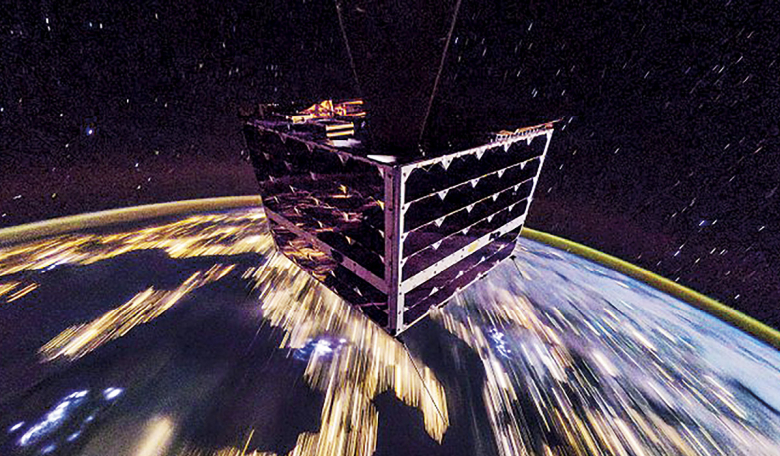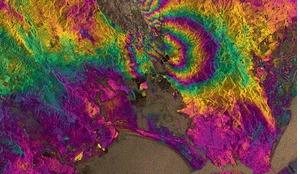Today’s ‘theatre of space’ features a far greater number and diversity of actors than during its early years and the ever-increasing demand for satellite data and services, along with the associated increase in launches and orbiting satellites, raises challenging questions for the long-term sustainability of space activities. In this Special Report for ROOM, Peter Martinez, Executive Director of the Secure World Foundation, proposes a multifaceted approach to address a problem that impacts not only many aspects of space activity but also everyday life on Earth.
Space sustainability is undoubtedly a topic of growing importance, as shown by the amount of attention given to it at space conferences in the past few years. The term “space sustainability” has only come into general use within the last 10 years or so and it is, strictly speaking, a misnomer, because it refers not to the sustainability of outer space itself, but to the ability of humanity to sustain its activities in outer space.
There are some interesting parallels between the concept of sustainable development on Earth and space sustainability. The concept of sustainable development, as we now understand it, had its genesis in the environmental movement of the 1960s and the 1970s. It arose out of concerns over environmental degradation due to pollution and gradually gave rise to the much broader concept of sustainable development now encapsulated in the 17 ‘Sustainable Development Goals’ adopted by the United Nations in 2015.
In a similar manner, what is now broadly understood to encompass space sustainability began with a concern about the degradation of Earth’s space environment through the proliferation of orbital debris. Deeper reflection has revealed that space debris is symptomatic of a broader set of issues that we now collectively refer to as space sustainability.
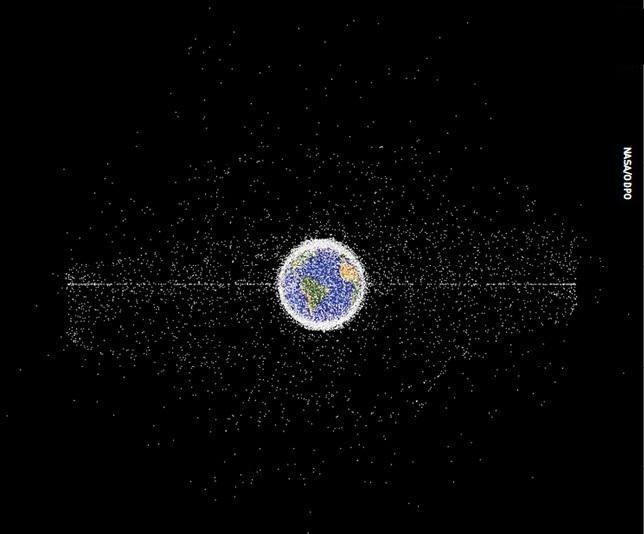 Graphic representing the crowding of Earth’s orbital environment, showing the high density of satellites in low Earth orbits (about 200–2000 km), the geosynchronous orbits at 35,785 km above the Earth’s equatorial plane, as well as many other satellites with more highly inclined orbits.
Graphic representing the crowding of Earth’s orbital environment, showing the high density of satellites in low Earth orbits (about 200–2000 km), the geosynchronous orbits at 35,785 km above the Earth’s equatorial plane, as well as many other satellites with more highly inclined orbits.
International guidelines
The topic of space sustainability has been addressed by the United Nations in a holistic manner since 2010. In 2019, the United Nations Committee on the Peaceful Uses of Outer Space (UN COPUOS) adopted a set of 21 consensus guidelines for ensuring the long-term sustainability of outer space activities. In the preamble to those guidelines, the following definition is given: ‘The long-term sustainability of outer space activities is defined as the ability to maintain the conduct of space activities indefinitely into the future in a manner that realises the objectives of equitable access to the benefits of the exploration and use of outer space for peaceful purposes, in order to meet the needs of the present generations while preserving the outer space environment for future generations.’
The definition of sustainable development contained in the seminal Brundtland Report, Our Common Future, is given as “development that meets the needs of the present without compromising the ability of future generations to meet their own needs”. Readers will notice a parallel between that definition of sustainable development on Earth and the UN COPUOS definition of space sustainability quoted above. This was a deliberate choice, meant to highlight the connection between space sustainability and sustainable development on Earth.
There are many nations with sovereign interests in space that must be accommodated equitably and sustainably, from both a geopolitical and an operational perspective, to preserve space as an orderly, stable and safe operating domain. Space sustainability is therefore an intrinsically global challenge that can only be addressed successfully through a coordinated global approach. The emphasis on a global approach really is important and timely because no State or corporation, no matter how capable, can ensure the safety and sustainability of space activities through their own efforts alone.
Space sustainability is also a multifaceted challenge that touches on the technical, operational, governance, diplomatic, security, finance and insurance aspects of space activities. Therefore, we will need a multifaceted approach that addresses all these dimensions. This, in turn, means that we need to have a coordinated multi-stakeholder approach to space sustainability that harnesses all of the capabilities, experience and competencies in governments, industry, academia and civil society.
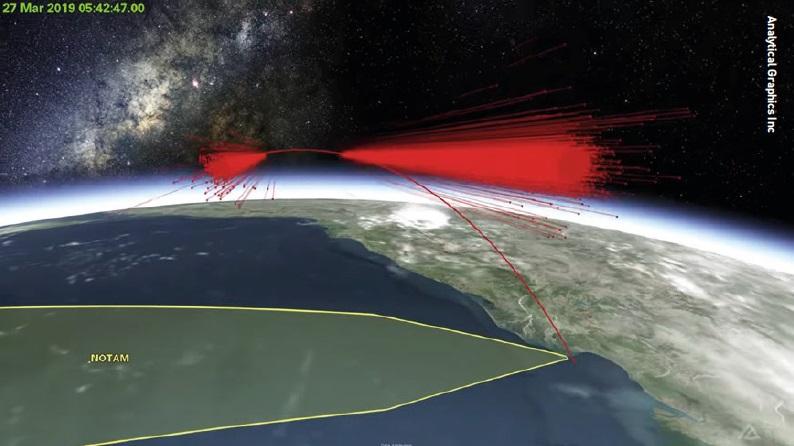 A simulation of space debris created by India’s ‘Mission Shakti’ anti-satellite missile test in March 2019. It created a slew of debris about 282 km (175 miles) above Earth, with some estimates suggesting that it created 6,500 pieces of space debris larger than a pencil eraser.
A simulation of space debris created by India’s ‘Mission Shakti’ anti-satellite missile test in March 2019. It created a slew of debris about 282 km (175 miles) above Earth, with some estimates suggesting that it created 6,500 pieces of space debris larger than a pencil eraser.
Three main challenges - the 3Cs
Space sustainability is an intrinsically global challenge that can only be addressed successfully through a coordinated global approach
The top three challenges to space sustainability can be identified in that space is becoming increasingly congested with active satellites, increasingly contaminated by space debris and increasingly contested by state and non-state actors alike.
As of mid-August 2023, there are now over 8500 active satellites in orbit. This number has been increasing exponentially in recent years, driven mainly by the launch of very large commercial satellite constellations, and it shows no sign of slowing down. Just one such constellation, Starlink, will have more satellites when it is completed than all the satellites that were launched by all nations in the world during the first 60 years of the Space Age. Looking at the other large constellations under development or being planned, we are likely to see tens of thousands of new satellites launched by the end of the decade.
Clearly, these rates of growth cannot be sustained indefinitely and, at some point, we will start to run up against the limitations of orbital carrying capacity. Long before that happens, we will need to develop some form of space traffic ‘rules of the orbit’ and a system to manage space traffic to avoid collisions. This increased congestion will drive the development of autonomous collision avoidance systems and stimulate a market for commercial space situational awareness data and services.
As impressive as the numbers of active satellites are, they represent only the tip of the iceberg in terms of the number of human-made objects in orbit around Earth. The space environmental legacy of the first six decades of the Space Age is a vast number of defunct satellites, mission-related debris, rocket bodies and fragments of objects in orbit. Active satellites represent fewer than 20 percent of the total population of tracked space objects.
Moreover, this tracked debris population represents the tip of the iceberg, as it corresponds to objects greater than 10 cm in size that can be consistently detected and tracked using optical and radar sensors. Beyond these trackable objects, there is a much, much larger population of objects that are too small to track. According to the European Space Agency (ESA) Space Debris Office, there may be as many as one million space debris objects ranging in size from 1 cm to 10 cm, and perhaps as many as 130 million from 1 mm to 1 cm. All of these objects pose collision hazards for active spacecraft and human spaceflight.
Collisions with the larger trackable objects can be avoided via collision avoidance manoeuvres (although not all active satellites have a manoeuvring capability), but the smaller debris objects are only known statistically and cannot be evaded because no orbital data exists.
This debris iceberg model is worth bearing in mind because space traffic management is really about managing encounters with only the small percentage of objects larger than 10 cm for which orbits can be predicted in time to screen for potential collisions. For the vast number of smaller, untrackable debris, we are statistically exposed to ‘taking the hit’ and have to design space systems to be resilient. Both collision avoidance and collision resilience involve additional operational costs and risks.
Finally, there is the political issue surrounding the contestation of orbital and other space resources by State and non-State actors alike. Earth’s orbital space and the frequencies of the electromagnetic spectrum constitute finite natural resources that must be used rationally and equitably. In the early days of the Space Age, this limitation was not evident and space operators could essentially ignore other operators most of the time. However, with the rapidly accelerating pace of space activities and growing congestion in orbit, we may soon start to run up against these natural limits.
Strategic domain
Space is becoming increasingly congested with active satellites, increasingly contaminated by space debris and increasingly contested by State and non-State actors alike
We are seeing a rapid increase in the number of new actors entering the space arena each year. These new actors are very diverse in terms of their space capabilities and motivations for conducting space activities, and most are non-State actors. Many come from other domains (e.g. IT) and may not be aware that they are entering a fragile and strategic domain.
Space is also becoming increasingly contested by military actors. Once seen purely as a means of enhancing military force projection capabilities on the ground, space is now increasingly seen as an operational or ‘warfighting’ domain as the militaries of the world’s leading space powers jostle for control of the ‘high ground’ of space.
The increasingly contested nature of space is leading to a worrying proliferation of counterspace capabilities to disrupt, degrade, deny or destroy the space capabilities of an adversary. These counterspace capabilities use kinetic as well as non-kinetic means of engagement; some cause temporary and reversible disruptions to space systems but others, such as direct-ascent anti-satellite missiles, are particularly worrying because they create large numbers of debris fragments that increase the collision risk to other space systems.
Existing frameworks
The three challenges of congestion, contamination and contestation – the 3Cs – are global in nature and take place within the context of the existing international governance framework for space activities. This legal framework comprises hard law in the form of an international treaty framework and national legislation, and soft law instruments such as principles, guidelines, recommended practices and standards.
The existing international treaty framework comprises five UN treaties that were developed in the late 1960s and 1970s, when States were the dominant space actors. Countries domesticate their legally binding obligations under these international treaties by enacting national legislation that is binding on space actors under their national jurisdiction. These legally binding treaties are supplemented by a number of non-binding UN General Assembly Resolutions, Principles and Guidelines, some of which may also be incorporated into binding national legislation or regulations.
But the situation in space is evolving rapidly and this body of hard law and soft law needs to be augmented to address new contexts and situations. This is particularly relevant for the commercial sector, which is starting to conduct space operations such as in-orbit servicing, in-orbit refuelling, active debris removal and other close-proximity orbital operations in the absence of widely shared rules of behaviour in orbit.
The lack of agreed rules has prompted several industry initiatives to discuss some common rules and standards for commercial space operations, for example. The Space Safety Coalition and the Consortium for the Execution of Rendezvous and Servicing Operations are two industry-led initiatives promoting best practices and standards. Another industry-led initiative is the Satellite Orbital Safety Best Practices reference guide developed jointly by the three large constellation operators, Iridium, OneWeb and SpaceX in September 2022.
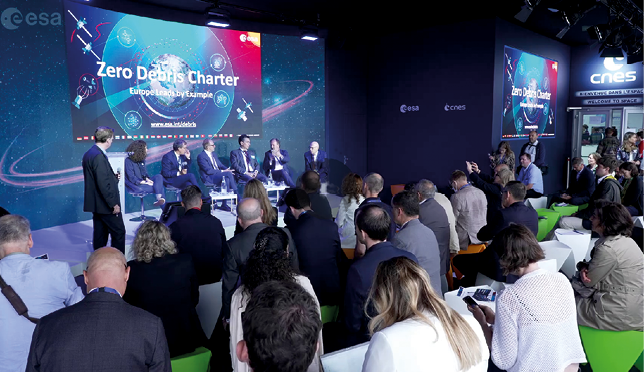 ESA Director General Josef Aschbacher and executives of Airbus Defence & Space, OHB and Thales Alenia Space announced during the 2023 Paris Air Show, they would jointly develop a ‘Zero Debris Charter’ with the overarching goal of preventing the creation of new debris, particularly in low Earth orbit.
ESA Director General Josef Aschbacher and executives of Airbus Defence & Space, OHB and Thales Alenia Space announced during the 2023 Paris Air Show, they would jointly develop a ‘Zero Debris Charter’ with the overarching goal of preventing the creation of new debris, particularly in low Earth orbit.
Ten steps to enhance space sustainability
Given the existing legal framework and initiatives to adapt this framework to cope with the 3Cs, it is possible to identify 10 additional measures that could be pursued to enhance the effectiveness of this existing framework.
1. Promote the universal adoption and implementation of existing space treaties and guidelines for space sustainability
The Outer Space Treaty (OST) is the foundational treaty for outer space activities; it was adopted in 1967 and has provided the international legal basis for all space activities ever since. The OST was followed by the Liability Convention in 1972 and the Registration Convention in 1975 which, respectively, clarify aspects of the OST regarding liability for accidents in space, in the atmosphere and on Earth, and for the registration of space objects. Given the growing pace of space activities, these three space treaties are now more relevant than ever.
These treaties have been very widely ratified but ratification is by no means universal. As of this writing, there are still more than 50 States that have not ratified the Outer Space Treaty. This means that there are countries launching objects into space that have not yet ratified the OST, the Registration Convention or the Liability Convention, which creates legal lacunae, or gaps, that could be exploited by unscrupulous actors. In terms of international law, States bear the international responsibility and liability for space activities by entities under their jurisdiction – this specifically includes commercial entities. States also have an obligation under the OST to authorise and supervise space activities by entities under their jurisdiction and many States meet these obligations through national legislation.
In addition to ratifying and implementing these three binding international treaties, States should also implement other relevant consensus instruments, such as the UN COPUOS Guidelines for the Long-term Sustainability of Outer Space Activities. These guidelines comprise a collection of internationally recognised measures for ensuring the long-term sustainability of outer space activities and for enhancing the safety of space operations. They address the policy, regulatory, operational, safety, scientific, technical, international-cooperation and capacity-building aspects of space activities.
The guidelines are intended to support States in the development of their national space capabilities in a manner that avoids causing harm to the outer space environment and the safety of space operations while allowing for flexibility to accommodate specific national circumstances. The guidelines are relevant to both governmental and non-governmental entities, to all space activities and to all phases of a space mission, including launch, operation and end-of-life disposal.
To be clear, these guidelines are minimum standards for the responsible conduct of space activities, but if all countries and all space actors were to implement them, that would be a significant contribution to advancing space sustainability.
 The environmental movement in the 1960s and the 1970s grew out of concerns about risks posed by pollution and overpopulation, and gave rise to a broader understanding of sustainable development on Earth. In a similar manner, the space sustainability narrative has emerged out of concerns about debris polluting the space environment.
The environmental movement in the 1960s and the 1970s grew out of concerns about risks posed by pollution and overpopulation, and gave rise to a broader understanding of sustainable development on Earth. In a similar manner, the space sustainability narrative has emerged out of concerns about debris polluting the space environment.
2. Act in a manner consistent with the recognition that near-Earth orbits and the electromagnetic spectrum are limited natural resources that have to be used equitably, efficiently and rationally
There has for a long time been recognition of the limited nature of radio frequencies through the International Telecommunication Union (ITU) coordination process, but there is a disconnect between the radio regulators and the regulators of launch and space operations. Many regulators still do not act in a manner that is fully cognisant of the reality that orbits are a finite natural resource that must be used rationally and equitably. When a national regulator issues a licence to an operator under its jurisdiction, it is essentially unilaterally allocating a portion of a shared global resource to that one operator.
In the past, when space systems comprised just one or a few satellites, this did not matter, but with the advent of very large constellations, this first-come, first-served approach can lead to a classic ‘tragedy of the commons’ situation where, if numerous independent actors enjoy unfettered access to a finite, valuable resource, they will tend to overuse it, and may end up destroying its value altogether. A first-come, first-served approach to allocating finite orbital resources to a small number of actors sets a dangerous precedent. Firstly, it encourages a rush to grab the available resource before others do. Secondly, it creates a dangerous asymmetry, where those excluded may consider that they have nothing to lose by disrupting the space systems of others.
Under the rubric of rational and efficient use of orbits, we should include the need to develop a system for space traffic management (STM), which has been discussed for some time. The following two points are relevant to the current discussion.
Firstly, when we consider STM, we can only actively manage the trajectory of a small fraction of the space objects in orbit and orbital debris cannot be directed in any way. Ultimately, we will have to remove large legacy debris objects from orbit as they pose the highest collision and debris proliferation risk.
Secondly, we will need to improve operator-to-operator coordination, because with growing congestion, more satellites will start to use autonomous collision avoidance systems. This means that at any given moment in the future, hundreds, if not thousands, of satellites could be changing their orbits ‘at will’ and without coordination. Thus we will need to improve data sharing in real time and develop common traffic rules that are known and followed by operators and autonomous collision avoidance systems alike. In particular, autonomous systems will need to have some way of exchanging information among themselves to coordinate their collision avoidance manoeuvres.
3. Assess the environmental impact of space systems over their entire life cycle
The increasingly contested nature of space is leading to a worrying proliferation of counterspace capabilities to disrupt, degrade, deny or destroy the space capabilities of an adversary
A proper evaluation of the environmental impact of space activities – on both the terrestrial and orbital environments – means that we need to consider all phases of space activities, starting with manufacture and assembly, through to launch and the potential atmospheric effects of rocket exhaust plume emissions, to the operational phase in orbit (collision/break-up risks, impact on dark/quiet skies), to post-mission disposal and risks associated with re-entry. We also need to consider the aggregate effect of a projected much larger number of atmospheric re-entries on the atmosphere itself.
4. Move away from a disposable culture in space towards a circular space economy
The space economy has traditionally relied on space systems that are used only once and then disposed of by atmospheric re-entry or by simply leaving system elements in orbit. We are literally throwing away valuable resources, such as precious metals, minerals and other materials. This approach generates a lot of waste that is hazardous for the space environment and is ultimately not a sustainable way of operating.
According to ESA estimates, there are more than 10,800 tons of mass in all the objects in Earth orbit. We have already paid the high energy cost to lift this mass out of the Earth’s gravitational well. We need to start thinking of defunct satellites and orbital debris as valuable resources that can be reused, repurposed and recycled by designing-out waste and pollution, and by keeping products and materials in use for as long as possible. This would be the first step toward a circular space economy.
A circular space economy could create many business opportunities and potential jobs in the repurposing, reusing and recycling industry. The commercial sector has a huge role to play in creating the necessary capabilities that would bring this about. Moreover, the existence of such commercial capabilities would open the door for regulators to impose more stringent post-mission disposal requirements that would limit harm to the orbital environment and the atmosphere, as well as the risks associated with the much higher number of atmospheric re-entries expected in future.
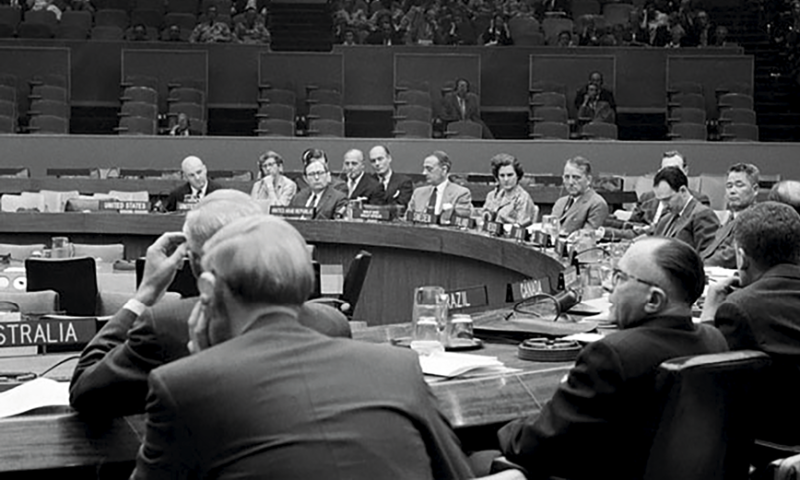 Negotiating the Outer Space Treaty (OST).
Negotiating the Outer Space Treaty (OST).
5. Design space systems for resiliency against natural and anthropogenic hazards
The lack of agreed rules has prompted several industry initiatives to discuss some common rules and standards for commercial space operationsSome
The space environment is a harsh operating environment in which spacecraft are subjected to a number of hazards, such as space weather, cosmic rays and meteors. In addition to the natural hazards of space, there are anthropogenic hazards and threats such as space debris, cyber attacks and counterspace threats. All of these hazards and threats can lead to the demise of a satellite, adding to the debris population in orbit.
With the advent of low-cost commercial off-the-shelf components and easier, cheaper access to space, there is a school of thought that argues for resilience through rapid replenishment and deploying large numbers of satellites in space, rather than through hardware design and the use of hardened components and shielding to enhance the survival prospects of a given satellite. However, as argued in item 4 above, the disposable culture is not something we want to encourage in space; we should instead promote the resilience of space systems against these natural and anthropogenic hazards. This can be achieved through the design and manufacture of space systems, through operational practices in orbit, and through regulatory and insurance incentives that promote and reward responsible and sustainable practices in space.
6. Use market access rules to shape behaviour
Space activities are now dominated by the commercial sector, which is subject to market forces of supply and demand. We should not rely on commercial actors self-regulating to ensure space sustainability because this could lead to the ‘free-rider problem’, where those who have the technical and operational means to address safety issues find that they bear the lion’s share of responsibility for things like collision avoidance, while other actors without such capabilities neglect to develop them unless compelled to do so by regulation (effectively getting a ‘free ride’).
As discussed earlier, States bear the international responsibility and liability for the space activities of commercial actors under their jurisdiction, which is why most spacefaring countries are adapting their national regulatory frameworks to keep pace with developments in the space arena. Regulations should have an underlying goal of constraining the risks associated with space activities and ensuring continued access to space for all through promoting the safety, security and sustainability of orbital activities.
There should be regulatory and insurance incentives to encourage all actors to play their part in supporting space sustainability and this can be done in the context of using market access rules to shape behaviour. Voluntary sustainability metrics, like the Space Sustainability Rating, also have a role to play in such incentives. We may soon see the emergence of other national certification and rating systems managed by independent entities that fill a role similar to Environmental, Social and Governance (ESG) ratings on Earth.
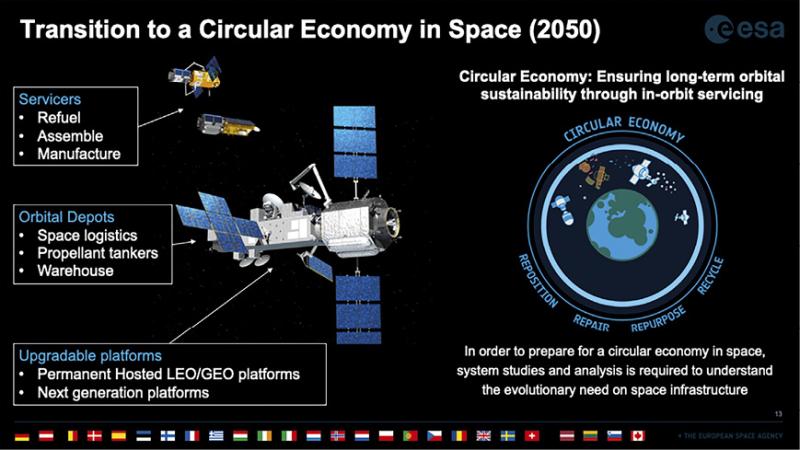 Some foundational elements of a circular space economy (ESA).
Some foundational elements of a circular space economy (ESA).
7. Determine how to quantify orbital carrying capacity and allocate it rationally and equitably
One does not need to be an astrodynamicist to appreciate that there is, in principle, a limit to the number of satellites that can be packed into the finite volume of space around the Earth. If we want to manage the limited orbital and spectrum resources equitably and rationally, we need to know the extent of these resources. This means we must find ways to quantify the total aggregate capacity and how much of it is being used by each space system. We must become highly efficient at using that capacity while it is occupied, and releasing capacity that is no longer being used for other actors to use. We must also come up with regulatory mechanisms to prevent hoarding of market access by a small number of actors.
The insurance industry also has a key role to play in promoting responsible behaviour in space. We must avoid making low Earth orbit (LEO) uninsurable, but rather work towards access to affordable insurance as one of the incentives for good behaviour.
8. Strengthen and harmonise space governance
Many regulators still do not act in a manner that is fully cognisant of the reality that orbits are a finite natural resource that must be used rationally and equitably
The regulation of different aspects of space activities (spectrum, launch and operations) is distributed across multiple agencies in most countries, each being responsible for regulating a different aspect of a given space activity. Traditionally the different types of national space regulators dealing with spectrum, space launch and space operations have tended to operate in silos, both internationally and nationally. We have gotten away with this approach in the past because of the very large orbital carrying capacity, but this capacity is finite, and we will start to experience its limitations soon as regulatory decisions made in one area have effects in another.
One particular challenge relates to the need for better coordination between the spectrum regulators and the space launch and space operations regulators. The issuing of radio licences for space systems comprising thousands of satellites has implications for space operations, yet traditionally in LEO the radio licencing process has not considered the impact of the authorised (from a radio perspective) space systems on the orbital environment, on orbital operations in LEO, and other factors such as post-mission disposal.
This has only been a consideration in geostationary orbit (GEO), where both the frequencies and the use of orbital positions are regulated by the ITU. But now, when radio regulators licence a system, they need to be mindful of the orbital carrying capacity issue. This is why we need to improve the coordination between the radio regulators and the launch and space operations regulators.
Moreover, a fragmented approach to regulation at national level can lead to governance challenges such as fragmented or divergent governance and chain-of-custody issues. Two examples of such chain-of-custody issues have already occurred. The first was the unauthorised launch of multiple unlicensed and untrackable small satellites by Swarm Technologies Inc in January 2018 in defiance of a ruling by the Federal Communications Commission, for which the company was subsequently fined US$900,000. The second involved the unauthorised placement of microscopic organisms (tardigrades) onto the Beresheet lunar mission, which subsequently crashed on the lunar surface in April 2019. These two cases point to the need for improved coordination among national regulatory authorities responsible for the authorisation and ongoing supervision of space activities.
Another aspect that will have to be addressed is the Article VI obligation in the Outer Space Treaty, which stipulates that States are responsible for the authorisation and continuing supervision of the space activities of entities under their jurisdiction and/or control. Traditionally, regulators have placed a great deal of emphasis on the authorisation component of this obligation, and rather less emphasis on the continuing supervision component. But with the growing congestion in space, it will become important to enforce post-mission disposal to ensure efficient use of the orbital capacity taken up by a country. In this regard, the development of commercial in-orbit servicing, refuelling and other rendezvous and close-proximity capabilities will create the possibility for regulators to require post-mission disposal, either through a capability intrinsic to the space system itself, or through commercially contracted means.
9. Promote responsible investment in space activities
A circular space economy could create many business opportunities and potential jobs in the repurposing, re-using and recycling industry
The exponential growth of commercial space activities in recent years has been fuelled by huge amounts of capital being poured into the space sector by venture capital firms, angel investors and a growing number of retail and institutional investors. Following a historical investment spike of US$16.5 billion in 2021, driven by a flurry of special purpose acquisition company (SPAC) mergers, direct investment in commercial space activities dropped to US$10 billion in 2022 due to a combination of market saturation, disappointing financial results of publicly listed emerging space companies and the deteriorating global macroeconomic context. However, 2023 showed signs of recovery with investments up by 29 percent year-on-year at the end of the first quarter.
The fast-evolving space sector continues to be seen as an alluring investment opportunity for many, with the more wildly optimistic forecasts predicting that the global space economy will surpass the trillion-dollar mark by the end of the decade. Such predictions are attracting the interest of analysts whose investment decisions are not necessarily informed by a deep knowledge of space as a fragile and strategic domain, but are influenced by reading optimistic analyses of space opportunities. The majority of these analyses focus on potential financial returns and make no reference to space sustainability concerns.
This situation gives rise to two concerns: the rate of growth and the venture capital mindset that accompanies such growth. With regard to the first concern, there is a real danger that we are seeing a space investment bubble that is growing at an unsustainable rate and will burst at some point. Alternatively, the cost of capital could rise to the point where it is no longer affordable to start-ups that have become accustomed to accessing cheap capital over the last few years. Either scenario could result in the failure of partially completed space projects, leaving large numbers of satellites essentially abandoned in orbit.
Alternatively, one or two spectacular mishaps in space could result in investors withdrawing from the space sector, leaving a large number of small companies with assets in space floundering. The second concern relates to the venture capital mindset of failing quickly, testing prototypes in the market and generating sales as soon as possible. Often investors in start-ups are looking to ‘cash out’ of their investments after a few years, not realising (or perhaps not caring) that space is a long game. These may be good strategies for finding lucrative high-tech start-ups on the ground, but they could be potentially disastrous for space sustainability. For these reasons, we should raise awareness among investment specialists who are new to the space sector that their investment decisions can have both positive and negative long-term effects, not only for their investors but also for all of humanity.
It is in the interests of investors to preserve space as a safe and stable operating environment, because if they don’t, this will greatly limit future space investment opportunities. Investors also need to realise that, in funding a project, they are taking up a finite amount of orbital capacity, which reduces the available capacity for others to participate in the space economy. This can have the effect of freezing out other aspiring space actors, which can ultimately have a destabilising effect on space security. We should not create asymmetries by blocking entire nations from participating in the space economy, because this leaves them with nothing to lose in disrupting the space activities of others.
10. Refrain from deliberate actions that degrade the space environment for all
One or two spectacular mishaps in space could result in investors withdrawing from the space sector
While there isn’t much that can be done right now about the legacy debris in orbit, we should take steps to avoid actions that create yet more orbital debris. One such entirely avoidable action is the conduct of debris-producing anti-satellite weapons tests. Dozens of ASAT weapons tests have been conducted since the 1960s, mostly by the United States and the former Soviet Union during the Cold War.
Although no such tests were performed from the late 1980s to the mid-2000s, since the mid-2000s we have seen direct-ascent missile intercepts performed by China (2007), the US (2008), India (2019) and the Russian Federation (2021). Altogether, these tests have created over 6,800 trackable pieces of orbital debris, of which more than 3,400 are still in orbit and pose hazards to satellites and human spaceflight.
Such tests, which are entirely avoidable, have produced more debris than other debris-producing events such as collisions and orbital breakups. Moreover, this debris poses a threat to all users of space, including human spaceflight, in the affected orbits, as debris cannot distinguish between geopolitical allies and rivals. The continued performance of such anti-satellite tests can no longer be regarded as a responsible activity in outer space, and a growing number of countries are calling for an end to such tests.
In the 2022 session of the UN General Assembly, a draft resolution was proposed which calls upon States to commit not to conduct direct-ascent anti-satellite missile tests in orbit. This resolution, No 77/41, was adopted by a large majority of 155 States that voted in favour of it. To date, 13 countries have made the commitment envisaged in the resolution, but only one of those actually has a direct-ascent anti-satellite missile capability. None of the other 12 plan to develop it, for the very reason that they consider that there should be an international norm against carrying out such tests.
Time is running out
The idea of sustainable development is now entrenched in society, business and politics, but it took several decades to achieve this. Discussions about the interaction of people, planet and development began in the 1960s with the environmental movement’s response to concerns over environmental pollution. Those dialogues led to a much richer understanding of all the dimensions of this issue and to what is now encapsulated within the notion of sustainable development.
The notion of space sustainability is much newer and goes back only a decade or so. It, too, has its origins in concerns about debris pollution of the space environment, but we now also see this as symptomatic of a more complex set of underlying, interrelated issues. However, because of the exponential growth of space activities, we do not have the luxury of a few more decades to address the challenges of the 3Cs. Urgent action is needed now if we are to avert a tragedy of the commons in space.
In the long term, we need to identify a set of globally shared goals for preserving the Earth’s orbital space environment as a domain for peaceful use for the benefit of all nations and future generations.
 Parallel streaks from SpaceX Starlink satellites visible over southern Brazil (the vertical streak is a meteor). Concern has been voiced by many in the astronomical community about how reflections from these satellites may affect our ability to peer through the increasingly crowded and bright night sky of our own planet to study the universe beyond.
Parallel streaks from SpaceX Starlink satellites visible over southern Brazil (the vertical streak is a meteor). Concern has been voiced by many in the astronomical community about how reflections from these satellites may affect our ability to peer through the increasingly crowded and bright night sky of our own planet to study the universe beyond.
Editor’s note
This Special Report is based on a keynote speech given by Peter Martinez at the 6th New Space Atlantic Summit held in Lisbon, Portugal on 10 May 2023, organised by the Portuguese Space Agency with the theme ‘A Global Effort for Space Sustainability’.
About the author
Peter Martinez is the Executive Director of the Secure World Foundation. He has extensive experience in multilateral space diplomacy, space policy formulation and space regulation, as well as capacity building in space science, technology and workforce development. Prior to joining Secure World Foundation he chaired the UN COPUOS Working Group on the Long-Term Sustainability of Outer Space Activities and the South African Council for Space Affairs.





